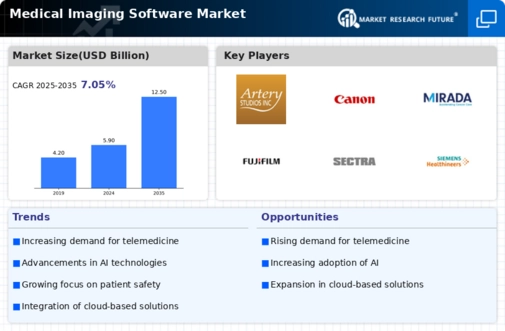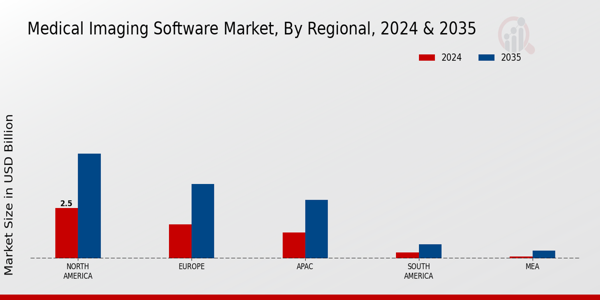Market Growth Chart
Technological Advancements
The Global Medical Imaging Software Market Industry experiences rapid growth due to continuous technological advancements. Innovations such as artificial intelligence and machine learning are enhancing image analysis, improving diagnostic accuracy and efficiency. For instance, AI algorithms can analyze imaging data faster than traditional methods, potentially reducing the time required for diagnosis. This trend is reflected in the projected market value, which is expected to reach 5.9 USD Billion in 2024 and grow to 12.5 USD Billion by 2035, indicating a robust demand for advanced imaging solutions.
Growing Geriatric Population
An aging population worldwide contributes significantly to the expansion of the Global Medical Imaging Software Market Industry. Older adults are more susceptible to various health issues, necessitating frequent imaging for diagnosis and monitoring. As the global geriatric population increases, healthcare systems are likely to invest in advanced imaging software to cater to this demographic. This trend aligns with the projected market growth, which is expected to see a CAGR of 7.06% from 2025 to 2035, reflecting the increasing need for effective imaging solutions tailored for elderly patients.
Increased Healthcare Expenditure
Rising healthcare expenditure across various nations is a crucial driver for the Global Medical Imaging Software Market Industry. Governments and private sectors are investing more in healthcare infrastructure, including advanced imaging technologies. This investment is essential for improving patient outcomes and enhancing diagnostic capabilities. As healthcare budgets expand, the demand for sophisticated imaging software is likely to rise, contributing to the market's growth trajectory. The expected increase in market value from 5.9 USD Billion in 2024 to 12.5 USD Billion by 2035 illustrates the financial commitment to enhancing medical imaging capabilities.
Regulatory Support and Standards
Regulatory support and the establishment of standards for medical imaging technologies play a pivotal role in the Global Medical Imaging Software Market Industry. Governments and health organizations are increasingly recognizing the importance of standardized imaging practices to ensure quality and safety in diagnostics. This regulatory framework encourages the adoption of advanced imaging software, as healthcare providers seek compliance with these standards. The anticipated growth in the market, projected to reach 12.5 USD Billion by 2035, suggests that regulatory initiatives may significantly influence the adoption of innovative imaging solutions.
Rising Prevalence of Chronic Diseases
The increasing prevalence of chronic diseases globally drives the demand for medical imaging software. Conditions such as cardiovascular diseases, cancer, and neurological disorders necessitate advanced imaging techniques for accurate diagnosis and treatment planning. The Global Medical Imaging Software Market Industry is likely to benefit from this trend, as healthcare providers seek efficient imaging solutions to manage these conditions. The anticipated growth from 5.9 USD Billion in 2024 to 12.5 USD Billion by 2035 underscores the urgency for innovative imaging technologies to support healthcare systems worldwide.











Leave a Comment